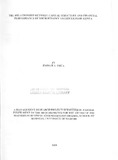| dc.contributor.author | Orua, Emmah A | |
| dc.date.accessioned | 2013-03-12T07:18:49Z | |
| dc.date.issued | 2009 | |
| dc.identifier.uri | http://erepository.uonbi.ac.ke:8080/xmlui/handle/123456789/13415 | |
| dc.description.abstract | This study examined the relationship between capital structure and performance of MFIs
in Kenya. Capital structure theories predict that leverage level influences a firm’s
performance. In MFIs outreach levels and default rates are considered essential
performance indicators that capture the success and sustainability of MFIs. Using these
indicators the relationships between capital structure and performance of MFIs can
therefore be measured in short term and long term. The objective of this study was to
establish the relationship between capital structure and financial performance of MFIs in
Kenya.
A survey that explores how capital structure relates to outreach level and default rate was
carried on Nairobi based MFIs. The population comprised 36 MFIs registered by AMFI
as at December 2008.Convenient sampling method was employed The main source of
data were the annual Financial and income statements from the MFIs gathered from the
MFIs offices and websites. From the financial and income statements panel data covering
five-year period from 2004 to 2008 was summarized using a secondary data collection
form and analyzed using ratios, descriptive statistics and multiple regression analyses.
The multiple regression models used considered performance as the dependent variable
and was measured in terms of Outreach and default rate. The independent variables in the
regression models included Short term debts, long term debts and total debts as a ratio of
totals assets while firm size, risk level and firm age were also used as control variables to
make up for other omitted. Variables
The findings showed that most of the MFIs employed high leverage. The mean total debt
ratio was 76%. Further the results showed that MFIs financed their operations with long
term as against short-term debts suggesting a considerable dependence on long-term
debts by MFIs for their operations. The MFIs studied were also found to enjoy
satisfactory performance recording mean values of 36% and 33% for ROA and ROE
respectively. A few MFIs were also found to be doing well while most of them are not as
suggested by standard deviation of 1.52 with respect to ROA hence overall mean could
be driven by a few MFIs. It was revealed that short-term debt significantly impacted MFI
outreach positively. Long term debt however showed positive relationship with outreach
but was not significant with regard to default rates, both short and long term debts
showed expected results but were not significant indicating that maturity may not
necessarily be of essence. Generally highly leveraged MFIs were found to perform better
by reaching out to more clients. It was also revealed that such MFIs also enjoyed
economies of scales and therefore were better able to deal with moral hazards and
adverse selections which also enhanced their ability to manage risks. | en |
| dc.language.iso | en | en |
| dc.publisher | University of Nairobi | en |
| dc.subject | capital structure | en |
| dc.subject | financial performance | en |
| dc.subject | microfinance institutions | en |
| dc.subject | kenya | en |
| dc.title | The relationship between capital structure and financial performance of Microfinance institutions in Kenya | en |
| dc.type | Thesis | en |
| local.publisher | School Of Business, University Of Nairobi | en |

